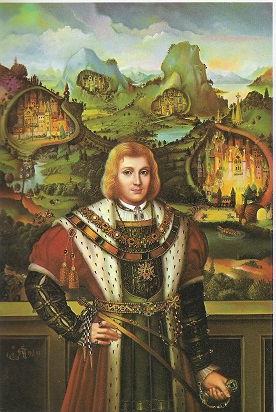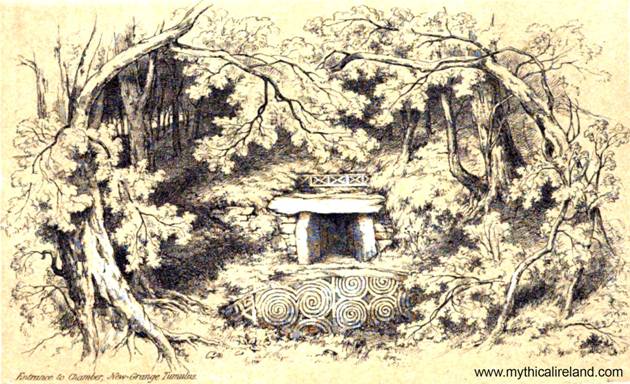THE KING OF THE FAERIES
THE DAGDA: THE KING OF THE GOLDEN COMPANY
[traduzione italiana]
Sull’Isola Verde le fate sono il popolo della Dea Danu (Tùatha Dé Danann/Danaan) sconfitto nell’ultima migrazione “celtica” dai Gaeli (provenienti molto probabilmente dalla Spagna) vedi.
I Milesi -da cui discendono gli irlandesi- erano solo uomini eppure riuscirono a sconfiggere un mitico popolo semi-divino, il quale si ritirò, grazie ai suoi poteri magici, in una dimensione sovrannaturale, invisibile. Il regno delle fate sono i sidhe (i grandi tumuli sepolcrali dell’Irlanda preceltica) e così sid (al singolare) e sidhe al plurale (Daoine Side) è il nome sia della fata che della sua dimora. Tuttavia le fate vivono anche nelle acque e nei boschi o nelle valli incontaminate dell’Isola, che non vollero abbandonare.
Va da sé che non c’è quindi un unico re delle fate, ma il re del Brú na Bóinne (il sito archeologico di Newgrange), il «Palazzo del fiume Boyne», è anche considerato il Signore dell’Oltre. Il tumulo sorge sulla riva settentrionale del fiume Boyne, a est di Slane (contea di Meath). Al tempo della ritirata di fronte all’avanzare del popolo degli uomini era re il Dagda (ma poi suo figlio Aengus ne prese il posto) vedi

IL DAGDA: RE DELLA COMPAGNIA DORATA
Nel ciclo delle invasioni di Ériu, padre spirituale dei Túatha Dé Dánann. Si adoperò per ottenere la vittoria contro i Fomoriani nella seconda battaglia di Mág Tuired. Fu re di Ériu per ottanta anni. Divise i síde tra i Túatha Dé Dánann quando essi lasciarono la terra ai Milesi. Risiedeva nel Brúg na Bóinne, da cui, secondo una tradizione, venne estromesso dal figlio Óengus Óc. La sua figura nasconde probabilmente qualche antico dio della morte e dell’aldilà. (tratto da bifrost.it qui)
[English translation]
The King of the Faeries in the Irish lore
In Ireland the people of the Goddess Danu (Tùatha Dé Danann), defeated in the last “Celtic” migration by the Gaeli (most likely coming from Spain) are considerated the Fairies –cf.
The Milesi were only men and yet they succeeded in defeating a mythical semi-divine people, who withdrew, thanks to his magical powers, in a supernatural, invisible dimension. The kingdom of fairies is the sidhe (the great burial mounds of pre-Celtic Ireland) and so sid (in the singular) and sidhe in the plural is the name of both the fairy and its home. However, the fairies also live in the waters and in the woods or in the pristine valleys of the island, which they did not want to abandon.
The king of Brú na Bóinne (the “Palace of the River Boyne”), the archaeological site of Newgrange, is considered the Lord of the Beyond, but there is not a single king of the fairies. The mound is located on the northern shore of the Boyne River, east of Slane (County Meath). At the time of the retreat in front of the advance of the people of the men, the Dagda was the king (but then his son Aengus took his place) see

| Chi sono costoro? «Angeli caduti che non erano abbastanza buoni da essere salvati, né abbastanza cattivi da essere cancellati» dicono i contadini. «Gli dèi della terra» dice il Libro di Armagh. «Gli dèi dell’Irlanda pagana» dicono alcuni studiosi di storia, «gli dèi delle Túatha Dé Danann, che, quando non furono più venerati e nutriti con le offerte, si rimpicciolirono secondo l’immaginazione popolare, e ora sono alti solo poche spanne». […]. Non pensate tuttavia che le fate siano sempre piccole. Nel loro mondo tutto è capriccioso, anche la loro statura. W.B. Yeats: Irish Fairy and Folk Tales |
THE KING OF THE FAERIES
“The King of the Fairies” è una melodia irlandese dedicata al Re delle Fate.
Una delle leggende connesse con la melodia dice che, se suonata per tre volte consecutive durante una festa, aveva il potere di far comparire il Re. Una volta evocato, il Re poteva unirsi alle danze, deliziato dalla festa e dalla musica, oppure creare gran scompiglio se deluso.
Una versione di questa melodia appare nel secondo volume del libro di James Aird, intitolato “Aird’s Airs”, nel 1789. Aird (morto nel 1795) era uno scozzese che gestiva un negozio di musica a Glasgow e pubblicò sei volumi (contenenti 1200 brani) tra il 1778 e il 1801. I suoi volumetti erano i più venduti in Scozia alla fine del XVIII secolo e furono usati come fonte da Robert Burns (1759-1796), e le melodie sono utilizzate in molte delle sue canzoni – vedi, ad es. , “The Songs of Robert Burns, ed. Donald Low (Routledge: 1993, p. 928). Un’altra versione della melodia “King of the Faries” è stata pubblicata in precedenza dall’irlandese John Edward Pigot (1822-1871) a metà del 1800. Alcune persone sospettano che il titolo si riferisca a Charlie Edward Stuart, meglio noto come Bonnie Prince Charlie (1720-1788), altri altrettanto dubbiosi, credono che si riferisca a Guglielmo d’Orange (1650-1694)
“The King of the Fairies” è un hornpipe, questa melodia in particolare è così delicata che viene eseguita spesso come danza femminile (step dance).
La melodia è stata anche riproposta in versione Folk-rock (ma anche Folk metal per esempio dai Waylander)
“The King of the Fairies” is an Irish tune dedicated to the Fairy King (in Gaelic Ri Na Sidheog) .
“One tale attached to the tune has it that “The King of the Fairies” is a summoning tune, and if played three times in a row during a festivity the King must appear. Once summoned, however, the King assesses the situation, and if the gathering is to his liking he may join in; if however, he does not find it to his liking he may cause great mischief” (from here) –
“A version of this tune appears in the second volume of the James Aird’s book of airs, entitled Aird’s Airs, in 1789. Aird (d. 1795) was a Scotsman running a music shop in Glasgow, and published six volumes (containing 1200 tunes) between 1778 and 1801. His small volumes were best-sellers in Scotland of the late 18th century, and were used as source-books by Robert Burns (1759-1796), and the tunes are used in many of his songs — see, e.g., The Songs of Robert Burns, ed. Donald Low (Routledge: 1993, p. 928). Another version of the tune “King of the Faries” was published earlier by the Irishman John Edward Pigot (1822–1871) in the mid-1800s. Some people dubiously claim the title refers to Charlie Edward Stuart, better known as Bonnie Prince Charlie (1720-1788), others just as dubiously say that it refers to William of Orange (1650-1694)” (from here)
“The King of the Fairies” is a hornpipe, often performed as a female dance (step dance). The melody was also re-proposed in a Folk-rock version (but also Folk metal for example by Waylander)
la quarta uscita di questo gruppo sloveno una versione più patinata anche qui in tre parti, la prima affidata alla chitarra acustica, la seconda al flauto e la terza all’organetto (il video è una sequenza di bellissime immagini dell’Irlanda)
LINK
http://bifrost.it/CELTI/6.TuathaDeDanann/01-TuathaDeDanann.html#A
http://bifrost.it/CELTI/7.Milesi/1-OriginedeiGaeli.html
http://bifrost.it/CELTI/Schedario2/DagdaMor.html
http://www.lacooltura.com/2015/12/tuatha-de-danann-i-semidivini/
http://ontanomagico.altervista.org/megalitismo.html
http://ontanomagico.altervista.org/religione-celti.html
http://thesession.org/tunes/475
http://tunearch.org/wiki/Annotation:King_of_the_Fairies_(The)
http://slowplayers.org/2014/05/05/king-of-the-fairies-edor/
http://ontanomagico.altervista.org/danze-irlandesi.html
http://terreceltiche.altervista.org/luovo-dellequinozio-di-primavera-e-la-danza#hornpipe
